Q&A – Ask Neil: September 19, 2024
(Please read these instructions carefully.)
Before you post your question, please look at recent issues to see if someone else has already asked it. You might find your answer there.
How to submit your question…
(Note: You may need to allow a pop-up window to come up in order to get the link for sending your photo(s). If you have already submitted your question and didn’t see the pop-up window, please click here.)
• Click the link provided below to post your question. After you submit your question, a new window will pop up giving you the address to which you can e-mail a SHARP, HIGH-RESOLUTION PHOTO to accompany your question. Please DO NOT SEND THUMBNAIL PHOTOS in case I need to zoom in to see things.
• Click here to post your question.
• Please ONLY POST YOUR QUESTION ONE TIME. We can only accept a set number of questions each week, and when we get duplicates it costs other people their chances.
• One question per reader, please.
• Please use this only for posting questions – not for standard emails.
• Watch for your answer in the following week’s e-gardens.
• I choose those of greatest general interest. For example, plant IDs seldom make the cut.
• I must have your first name or initials.
• I must have your city or county. (Texas is a very large state.)
An update on Emerald Ash Borers…
Before I begin with this week’s answers to your questions, I want to tweak an answer I gave last week.
It was in my closing comment of Answer 4, Sept. 12, Q&A, where I was addressing the Emerald Ash Borers that have now started showing up in several counties in Texas. They have destroyed vast ash forests through the Upper Midwest and Eastern U.S., and now all species of ash are threatened in Texas.
I closed with the sentence, “Unfortunately we do not have a preventive or cure for them.”
My good friend, advertiser, and highly respected former Texas Arborist of the Year Steve Houser of Arborilogical Services was kind enough to drop me a note:
“There is a material that will prevent damage by Emerald Ash Borers for as long as two years. The treatments can be costly over time as they require re-treatment to prevent new infestations. Experts say that after 10 years the Emerald Ash Borers will have likely moved on and may not require further treatment.”
I’m always grateful to Steve for his insights. We all need friends like him.
My personal recommendation is that homeowners should always look to certified arborists for anything as challenging as dealing with Emerald Ash Borers. This is not a project for an average home gardener.
QUESTION 1
WHAT IS THIS PLANT? I NEED TO REPLACE ONE.
Question: What kind of shrub is this? It has green and burgundy leaves and small thorns. One has died and I’d like to replace it due to the color contrast with my other plants. Danny S., Arlington.
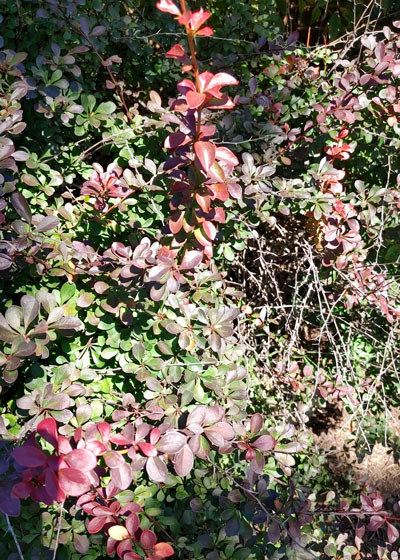
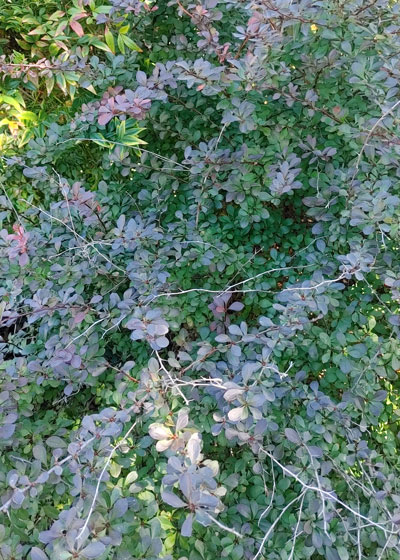
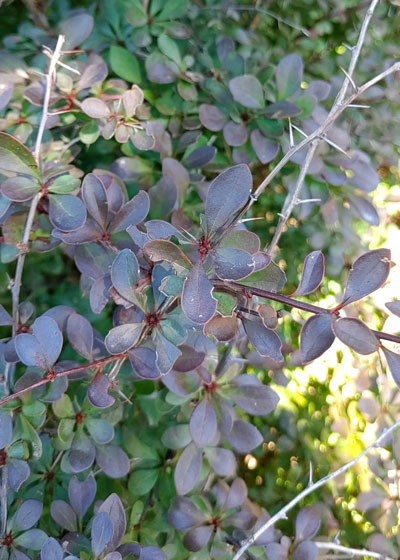
Answer: You have a barberry, but I can’t tell which cultivar. There are several fairly commonly sold in the nursery trade including Orange Rocket, Rosy Glow, and the old favorite dwarf type Crimson Pygmy. I’d suggest you start with a tape measure or yardstick to determine the height of your tallest surviving plant. Take photos of the best variegation you find (probably in the sunniest part of the planting) and do a little research online. I normally try to keep my answers and my advertisers separated as much as possible, but I know that the managers at Calloway’s are Texas Certified (and Master Certified) Nursery Professionals. They also handle several different types at both of their stores there in Arlington. They would be glad to help you pick the right one to match. I will add that barberries tend to be a bit picky about sun and drought. Their tolerance of the latter is limited under Texas conditions, so keep your plants, especially the new plant, moist at all times.
QUESTION 2
HOW CAN I HELP MY MAGNOLIA?
Question: What can I do to pretty up my magnolia? It has dead branches, mostly facing the sun. It had a hard time last summer. Evelyn P., Weatherford.
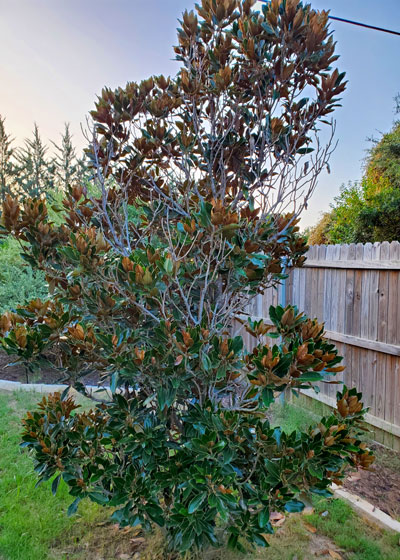
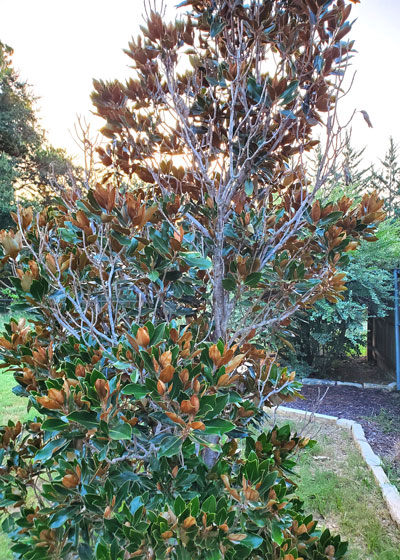
Answer: I’ll bet it will surprise you. Begin by trimming out the dead branches using lopping shears. Make each cut flush with the remaining branch or trunk. In other words, leave no stubs. Then determine if you need to do any reshaping by removing any of the healthy branches just to get symmetry back. I would then apply an all-nitrogen fertilizer (same type you use on your turf – just be sure it does not have a weedkiller included). Water the fertilizer into the soil thoroughly. Keep the tree well fed and thoroughly moist at all times this fall, winter and through next spring and summer. It will respond with good new growth come spring.
QUESTION 3
WHAT IS KILLING MY MONTEREY OAKS?
Question: What is killing my Monterey oaks? Is this borer damage? I thought they were adequately watered. They are two years old. Ashley B., Poth (San Antonio area).
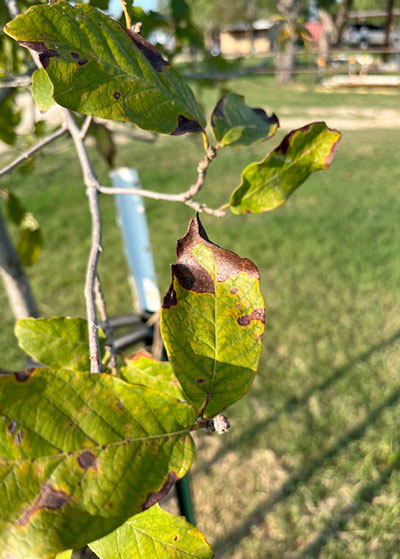
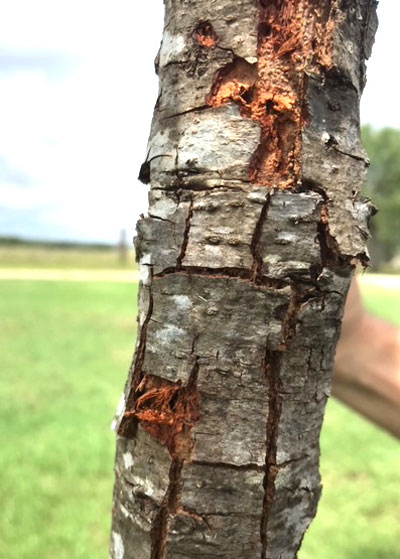
Answer: When I see bark splitting like a couple of your photos I immediately think of sunscald, so that remains on the table. It may have come first. But the photo with your arm showing definitely looks like the work of borers. Those cinnamon-colored subsurface piles of sawdust would be the frass kicked out by the larvae as they chewed their tunnels through the wood of the trunk. As they made those tunnels they cut off the water and nutrient flow up to the leaves. Open up a paper clip. If you can easily push it up into the hole/tunnel, your tree has been damaged by borers and it’s probably too late to do much to help. That’s what caused the leaf scorch and dieback. Based on what I can see in your photos, that would be my guess. If you decide to plant more Monterey oaks (or any other tree species with ultra-thin bark including Shumard red oaks, water oaks, Chinquapin oaks, Chinese pistachios, and red maples), be sure you apply paper tree wrap from the ground up to the lowest branches. The wrap protects against sun scald and borer invasion.
QUESTION 4
DO SPIRAEAS STRUGGLE WITH TEXAS SUMMERS?
Question: Are spiraeas typically happier in the spring? Mine begin looking really tired once it turns hot and dry. Is there anything I can do to help them? They’re in the sun until about 3 p.m. Heath T., Whitesboro.
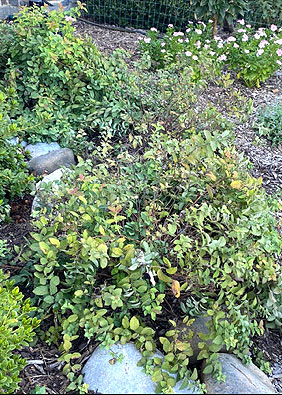
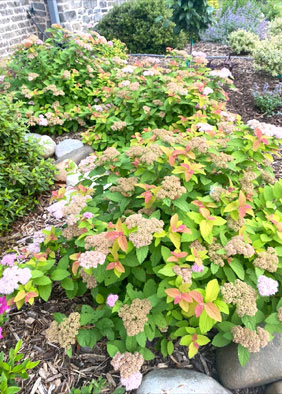
Answer: I garden in McKinney. I’ve had the best luck growing them in morning sun (until 10 or 11) and then shade the rest of the day. That’s especially been the case with Anthony Waterer and also some of the newer types. I garden where soils and irrigation water are both very alkaline. I don’t know what you have, but I know those alkalinity issues stress my spiraeas when it begins to turn hot and dry in the summer. Iron deficiency definitely becomes a problem. Somewhere in your pretty landscape you might try one of the Petite series of crape myrtles. There are six or seven different selections, with pink, lavender, and white definitely being included. They can be treated almost like perennials and sheared heavily in February to keep them quite short, and they will bloom repeatedly all summer. They might give you a nice change of pace in a few places. Autumn sage (Salvia greggii) would be another great candidate. Again, there are pink types. Those are just suggestions if the spiraeas wear out their welcome or if you want a change in some of the spots.
QUESTION 5
WHAT DEER-PROOF GROUNDCOVER COULD I GROW BENEATH A LARGE OAK?
Question: I have a 40-in. diameter oak. I’m in need of a groundcover that deer would leave alone. They have pulled out mondograss by its roots, also frogfruit, and liriope. Any suggestions? Rita M., Pilot Point.
Answer: This is the best list I have seen on the topic. It was prepared by friends in Bexar County, and I refer to it often. However, I do note that there aren’t a lot of groundcovers, and most require full sunlight. Wedelia would probably be the best from this list. I normally would suggest some of the prickly hollies like dwarf Chinese holly, but I don’t see it listed. I would still try it in a nice cluster of 9 or 11 plants, with the groundcover plants around it. I might also try a few purple wintercreeper euonymus plants just to see if the deer hopefully opted to avoid them. I’ve used a lot of it in our shade, and I’ve been quite pleased with the results.
QUESTION 6
HOW CAN I STOP MY ABELIAS FROM BEING SO “WOODY?”

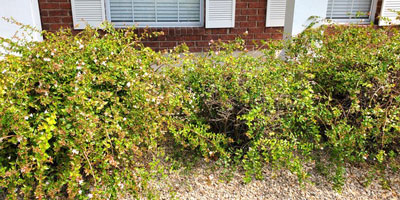
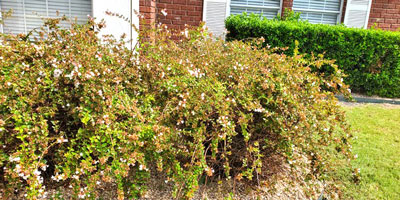
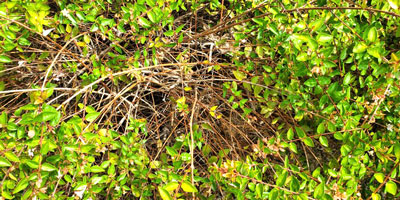
Question: These abelias are about 18 years old. Every February I cut them back to about 16 inches. Each year they seem to be getting more “woody.” They face south. What can I do? Pam B., Rockwall County.
Answer: When we trim shrubs to the same height each year we basically are “punishing” them for their good growth. That’s not meant to condemn you for doing it. It’s just meant to explain why the shrubs react that way. They’re getting tired because you’re removing the growth they’ve worked hard to produce. I would suggest removing some of the woodiest stems next February by using lopping shears. Try to even all the plants up as best you can. Apply an all-nitrogen plant food and water them heavily. You should have a burst of new growth almost immediately. Don’t let the new shoots grow way beyond the rest of the plants’ canopies. You should be fine.
On a separate track, 18 years is a long time for abelias. You might consider this as an opportunity to redecorate your two beds by planting a couple of clusters of other shrubs in rounded groupings in the circles. Nothing fancy – just simple clusters of low-growing plants such as dwarf yaupons, Harbour dwarf nandinas, etc., and then a grouping of very slightly taller shrubs at either end, with a groundcover tying it all together.
QUESTION 7
WHY DOES MY HOLLY BUSH HAVE DEAD SPOTS?
Question: Why is my holly bush developing dead spots after 25 years? It’s being watered regularly, and I don’t see any signs of insects. Janet E., Plano.
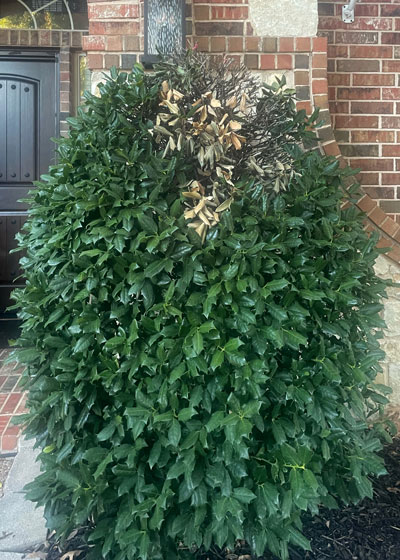
Answer: If it makes you feel any better, I had it happen last month to a 45-year-old Nellie R. Stevens holly along our driveway, also to a 3-year-old Oakland holly at the corner of our house. I’m pretty sure both of them got very marginally too dry. Like you, I saw no signs of insects, and it certainly wasn’t a disease. These past three summers have just been rough times to be a holly. Trim out the dead branches, reshape your plant as needed, fertilize it, and water it, and let’s see how we’re doing by springtime.
